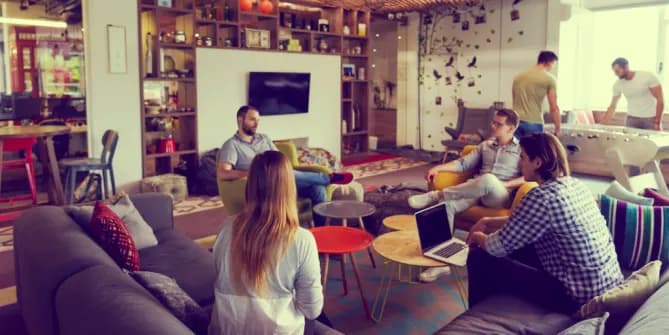4 Office Design Elements That Lead to More Innovative, Productive Employees
An office space should have comfortable and practical office furniture, meeting rooms, private offices, coworking spaces and a desk for everyone to feel like its a productive work environment. But an office layout isn't easy to design. Office layouts and interior design have changed since the days when cubicles reigned supreme.
According to the architecture firm Benhar Office Interiors, up to 70 percent of offices have replaced traditional cubicles with open-plans with shared, co-working spaces. The New York Times describes how Silicon Valley redefined what work environments look and feel like: “Tech companies built playful offices with beanbags and Ping-Pong tables, making work spaces less formal.”
At first glance, these design trends make offices look welcoming and fun. But do they drive business results? Do they increase employee productivity and engagement?
The global architecture firm Gensler, which has been designing office spaces for more than 50 years, has researched the impact of office design with innovation. Gensler stresses that today’s office designs have shifted from a focus on efficiency and productivity to innovation. Findings from Gensler’s U.S. Workplace 2016 survey of more than 4,000 workers across 11 industries revealed that “the most innovative companies provide their organizations with a diversity of well-designed spaces in which to collaborate and to focus, as well as empowering employees with the ability to work when and where best suits their work needs.”
In other words, if companies want employees to innovate, the physical layout of work environments play a strategic role. The overarching principle is simple: Mix it up. Work spaces that emphasize four key traits — collaboration, focus, taking breaks and natural light — all positively impact employee well-being and performance:
1. Collaboration:
According the Gensler study, employees “in innovative workplaces work from conference rooms more than they work from open areas.” Gensler measured that employees in “(h)igher performing, more innovative workplaces are 10 percent more collaborative than less innovative workplaces and there is twice the amount of learning going on.” When translated into office layout, high-performing companies have areas that are specifically designed for teamwork.
2. Focus:
At the same time, employees also must be able to hear themselves think. According to Gensler, “individual focus work” constitutes about 45 percent of office time. But privacy can be a trade-off in some layouts; Benhar Open Interior warns that too much open space can reduce productivity because “instead of collaborating, employees wear headphones all day and take work home to get things done.” To counter this, effective workspaces include accessible private spaces, like quiet break-out rooms that block ambient sound.
3. Taking breaks:
Space that helps employees tune out work also serve an important purpose. Fast Company cites research that employees should plan for 15 minutes of break time for every 75 to 90 minutes of work; the benefits can “boost mental resources such as attention, ensuring good performance.” According to Psychology Today, the key to an “effective break” is “psychological detachment” or literally, “mentally disengaging from work thoughts.” Translated into design, innovative work places include non-work spaces for play, movement, relaxation, or socializing.
4. Natural light.
According to neuroscientist Ivy Cheung from Northwestern University, “light is the most important synchronizing agent for brain and body." Results from a study that compared the health of workers in windowless offices with those who worked in offices with windows concluded that exposure to natural light positively impacts overall health and sleep. Furthermore research from the University of North Carolina concluded that the different colors/temperature of light exposure impacts workplace productivity. Windows, well-placed glass within an office to diffuse light, or sun-like lamps, can boost employee wellbeing.
Overall, office spaces designed to enhance innovation share one common trait: choice. Employees in these settings do not feel, in Gensler’s words, “chained to a desk.” As Marcus DiNotto writes in BizJournals.com: “Whether it’s millennials vs. GenXers, introverts vs. extroverts, or soloists vs. collaborators, a workspace that includes areas for every type of worker will help maximize productivity.”
--
Susan Margolin currently writes and conducts research for corporate clients. Previously, she worked for more than a decade launching new products and brands in Asia’s emerging markets. She holds degrees from Harvard (BA, MPA) and Northwestern University (MBA).
Why women love us:
- Daily articles on career topics
- Jobs at companies dedicated to hiring more women
- Advice and support from an authentic community
- Events that help you level up in your career
- Free membership, always
